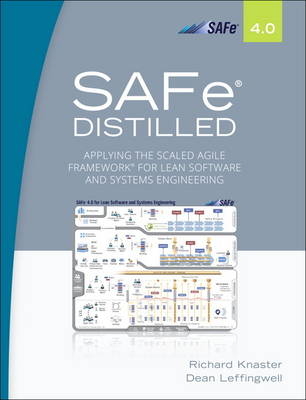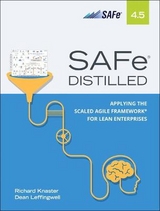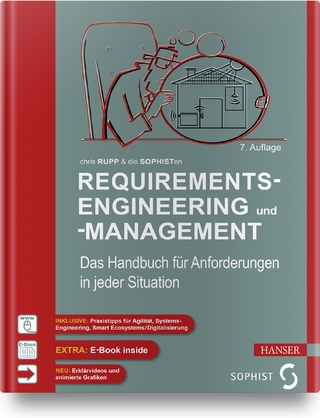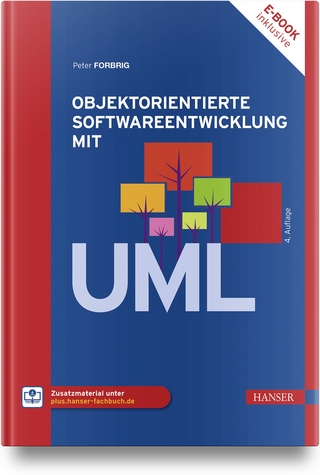
SAFe 4.0 Distilled
Addison-Wesley Educational Publishers Inc (Verlag)
978-0-13-420942-5 (ISBN)
- Titel erscheint in neuer Auflage
- Artikel merken
SAFe®: The World’s Leading Framework for Enterprise Agility“SAFe® 4.0 Distilled is the book we’ve all been waiting for. It breaks down the complexity of the Framework into easily digestible explanations and actionable guidance. A must-have resource for beginners as well as seasoned practitioners.”
—Lee Cunningham, Sr. Director, Enterprise Agile Strategy at VersionOne, Inc.
To succeed in today’s adapt-or-die marketplace, businesses must be able to rapidly change the way they create and deliver value to their customers. Hundreds of the world’s most successful companies—including Hewlett Packard Enterprise, AstraZeneca, Cisco, and Philips—have turned to the Scaled Agile Framework® (SAFe®) to achieve agility at scale and maintain a competitive edge.
SAFe® 4.0 Distilled: Applying the Scaled Agile Framework® for Lean Software and Systems Engineering explains how adopting SAFe can quickly improve time to market and increase productivity, quality, and employee engagement.
In this book, you will
Understand the business case for SAFe: its benefits, the problems it solves, and how to apply it
Get an overview of SAFe across all parts of the business: team, program, value stream, and portfolio
Learn why SAFe works: the power of SAFe’s Lean-Agile mindset, values, and principles
Discover how systems thinking, Agile development, and Lean product development form the underlying basis for SAFe
Learn how to become a Lean-Agile leader and effectively drive an enterprise-wide transformation
Richard Knaster, SAFe Fellow and Principal Consultant at Scaled Agile, Inc., has more than 25 years’ experience in software development in roles ranging from developer to executive and has been involved in Agile for more than a decade. Prior to joining Scaled Agile, Inc., Richard worked at IBM, where his career spanned from product line management (PPM domain) and professional services to chief methodologist, Agile and Lean. Richard is a certified IBM Thought Leader and an Open Group Distinguished IT Specialist. He is also a certified SPC, PSM, Agile Certified Practitioner, PMP, and a contributor to the Disciplined Agile Delivery framework and PMI Portfolio/Program Management standards. He was a contributor to SAFe(R) 4.0 Reference Guide (Addison-Wesley, 2017). Dean Leffingwell, creator of SAFe®, is widely recognized as the one of the world’s foremost authorities on Lean-Agile best practices. He is an author, serial entrepreneur, and software systems development methodologist. He is author of SAFe(R) 4.0 Reference Guide (Addison-Wesley, 2017). His two best-selling books, Agile Software Requirements: Lean Requirements Practices for Teams, Programs, and the Enterprise (Addison-Wesley, 2011), and Scaling Software Agility: Best Practices for Large Enterprises (Addison-Wesley, 2007), form much of the basis of modern thinking on Lean-Agile practices and principles.
Preface xiii
Acknowledgments xvii
About the Authors xix
Part I: Overview 1
Chapter 1: Business Need for SAFe 3
Why Do Businesses Need SAFe? 3
The Challenge of System Development 4
Applying New Bodies of Knowledge 5
Improving System Development Outcomes 9
The Business Benefits of SAFe 10
Summary 13
Chapter 2: SAFe Overview 15
The Big Picture 15
The Levels 17
The Foundation 22
The Spanning Palette 24
Summary 25
Part II: The Foundation of SAFe 27
Chapter 3: Lean-Agile Mindset 29
Overview 29
Thinking Lean 30
Embracing Agility 33
Applying the Agile Manifesto at Scale 37
Summary 40
Chapter 4: Lean-Agile Leaders 41
Exhibit the Lean-Agile Mindset 42
Lead the Change 42
Know the Way and Emphasize Lifelong Learning 47
Develop People 48
Inspire and Align with Mission. Minimize Constraints 52
Decentralize Decision-Making 53
Unlock the Intrinsic Motivation of Knowledge Workers 54
Evolve the Development Manager Role 55
Summary 58
Chapter 5: SAFe Principles 61
Why Focus on Principles? 61
Principle #1: Take an Economic View 62
Principle #2: Apply Systems Thinking 70
Principle #3: Assume Variability; Preserve Options 74
Principle #4: Build Incrementally with Fast, Integrated Learning Cycles 76
Principle #5: Base Milestones on Objective Evaluation of Working Systems 79
Principle #6: Visualize and Limit WIP, Reduce Batch Sizes, and Manage Queue Lengths 80
Principle #7: Apply Cadence; Synchronize with Cross-Domain Planning 83
Principle #8: Unlock the Intrinsic Motivation of Knowledge Workers 87
Principle #9: Decentralize Decision-Making 89
Summary 91
Part III: Program and Team Level 93
Chapter 6: The Agile Release Train 95
Overview 95
ART Organization 97
Develop on Cadence. Release Any Time 100
Vision 102
Features 103
Program Backlog 104
Roadmap 104
Agile Teams Power the Train 105
User Stories and the Team Backlog 107
Summary 111
Chapter 7: Planning a Program Increment 113
Overview 113
Preparation for the PI Planning Event 115
Day 1—Create and Review Draft Plans 118
Day 2—Finalize Plans and Commit 125
Summary 133
Chapter 8: Executing a Program Increment 135
Overview 135
The Iteration Cycle 136
Building Quality In 140
Improving Team Flow with Kanban 143
Managing ART Flow 146
System Demo 154
Innovation and Planning 154
Inspect and Adapt 156
Summary 156
Chapter 9: Inspect and Adapt 159
Overview 159
PI System Demo 160
Quantitative Measurement 160
Retrospective and Problem-Solving Workshop 162
Inspect and Adapt at the Value Stream Level 166
Summary 167
Part IV: Value Stream Level 169
Chapter 10: Value Stream Overview 171
Overview 171
Economic Framework 173
Capabilities and the Value Stream Backlog 176
Value Stream Epics 177
Defining and Building the Solution 178
Value Stream Flow 179
Summary 180
Chapter 11: Defining Large and Complex Solutions 183
Overview 183
The Solution 184
Solution Intent 186
Fixed and Variable Solution Intent 187
Developing Solution Intent 188
Documenting Solution Intent 191
Solution Context 192
Summary 196
Chapter 12: Coordinating ARTs and Suppliers 197
Overview 197
Value Stream PI Planning 198
ART PI Planning 200
Value Stream Post-PI Planning 201
Frequent Solution Integration 204
Value Stream Sync 206
Solution Demo 206
Value Stream Inspect and Adapt 207
Summary 207
Part V: Portfolio 209
Chapter 13: Portfolio Level Overview 211
Overview 211
Connecting the Portfolio to the Business 213
Defining Strategic Themes for a Portfolio 213
Influence of Strategic Themes 214
Measuring Progress against Strategic Themes 215
Portfolio Roles 215
Lean-Agile Program Portfolio Management 218
Advancing Solution Behavior with Portfolio Epics 221
Establishing Enterprise Value Flow 223
Coordinating Value Streams 225
Summary 228
Chapter 14: Lean-Agile Budgeting, Forecasting, and Contracting 231
Introduction 231
Lean-Agile Budgeting 231
Lean-Agile Planning and Forecasting 235
Lean-Agile Contracting 237
Agile Capitalization Strategies 243
Summary 247
Part VI: Implementing SAFe 249
Chapter 15: The Guiding Coalition 251
Introduction 251
The Implementation Roadmap 252
Reaching the Tipping Point 253
The Need for a Powerful Coalition 255
Train Lean-Agile Change Agents 255
Train Executives, Managers, and Leaders 256
Charter a Lean-Agile Center of Excellence 257
Summary 258
Chapter 16: Design the Implementation 259
Introduction 259
Create the Implementation Plan 265
Summary 268
Chapter 17: Implementing Agile Release Trains 269
Introduction 269
Prepare for the ART Launch 270
Train Teams and Launch the ART 277
The Quick-Start Approach to ART Launch 280
Coach ART Execution 281
Launch More ARTs in the Value Stream 282
Launch More Value Streams in the Portfolio 284
Summary 285
Chapter 18: Sustain and Improve 287
Introduction 287
Advance Organizational Maturity 288
Implement Agile HR Practices292
Measure and Take Action 293
Improve Agile Architecture and Technical Practices 295
Focus on DevOps and Continuous Delivery 297
Reduce Time to Market with Value Stream Mapping 298
Summary 299
Chapter 19: Essential SAFe 301
Overview 301
Lean-Agile Principles 303
Agile Teams and Release Trains 306
Cadence and Synchronization 308
Essential Team and Program Roles 310
PI Planning 312
System Demo 313
Inspect and Adapt 314
IP Iteration 315
DevOps Pipeline 316
Lean-Agile Leadership 317
Summary 319
Abbreviations 321
Glossary 323
Index 335
| Erscheint lt. Verlag | 10.4.2017 |
|---|---|
| Verlagsort | New Jersey |
| Sprache | englisch |
| Maße | 180 x 230 mm |
| Gewicht | 747 g |
| Themenwelt | Informatik ► Software Entwicklung ► Agile Software Entwicklung |
| ISBN-10 | 0-13-420942-7 / 0134209427 |
| ISBN-13 | 978-0-13-420942-5 / 9780134209425 |
| Zustand | Neuware |
| Informationen gemäß Produktsicherheitsverordnung (GPSR) | |
| Haben Sie eine Frage zum Produkt? |
aus dem Bereich



